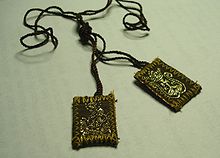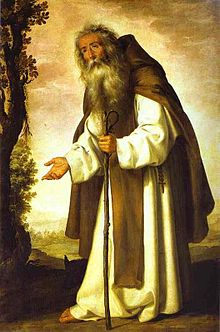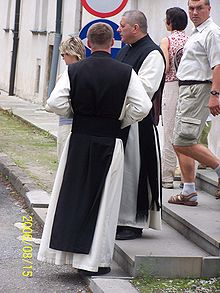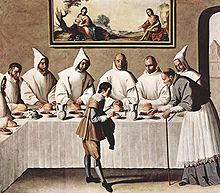- Scapular
-
The term scapular (from Latin scapulae, "shoulders") as used today refers to two specific, yet related, Christian Sacramentals, namely the monastic and devotional scapulars, although both forms may simply be referred to as "scapular".[1][2]
The "monastic scapular" appeared first, perhaps as early as the 7th century in the Order of Saint Benedict.[3] It is a somewhat large length of cloth suspended both front and back from the shoulders of the wearer, often reaching to the knees. It may vary in shape, color, size and style. Monastic scapulars originated as aprons worn by medieval monks, and were later extended to habits for members of religious organizations, orders or confraternities. Monastic scapulars now form part of the habit of monks and nuns in many Christian orders.[4][5]
The "devotional scapular" is a much smaller item and evolved from the monastic scapular. These may also be worn by individuals who are not members of a monastic order and the Roman Catholic Church considers them sacramentals. The devotional scapular typically consists of two small (usually rectangular) pieces of cloth, wood or laminated paper, a few inches in size which may bear religious images or text. These are joined by two bands of cloth and the wearer places one square on the chest, rests the bands one on each shoulder and lets the second square drop down the back.[6][7]
In many cases, both forms of the scapular come with a set of promises for the faithful who wear them. Some of the promises are rooted in tradition, and others have been formally approved by religious leaders. For instance, for Roman Catholics, as for some other sacramentals, over the centuries several popes have approved specific indulgences for scapulars.[8] [9]
Contents
History
 Painting of Saint Teresa of Avila, Doctor of the Church wearing the Carmelite Brown Scapular, by Rubens, 1615, Museum of Art History, Vienna.
Painting of Saint Teresa of Avila, Doctor of the Church wearing the Carmelite Brown Scapular, by Rubens, 1615, Museum of Art History, Vienna.
The exact origin of the scapular as a practical garment continues to be debated by scholars.[10] However, many sources agree that the scapular emerged from an apron-like piece of cloth worn by monks. Item 55 of the Rule of Saint Benedict, dating to the 7th century, clearly refers to the use of the scapular.[4][11][12][13] In the Western Church the key elements of a monk's habit eventually became the tunic, the cincture, the scapular and the hood. A nun's costume included the tunic, the scapular and the head veil.[14] Some authors interpret the scapular as a symbolic apron based on the fact that monks and nuns, when engaged on some manual labor, tend to cover it with a protective apron or carefully tuck it up or throw the front length back over their shoulder to prevent it from getting in the way.[15]
The fact that specific promises and indulgences were attached to the wearing of scapulars helped increase their following, as was seen with the early example of the Brown Scapular, habit of the Carmelites, which included the traditional promise that those wearing it piously would be spared the fires of Hell.[16] This promise was based on the Carmelite tradition that the Blessed Virgin Mary appeared to St. Simon Stock at Cambridge, England in 1251 in answer to his appeal for help for his oppressed order and recommended the Brown Scapular of the Our Lady of Mount Carmel to him and promised salvation for the faithful who wore it piously.[17][18][19] However, this issue is subject to debate among scholars. Today historians question whether this Marian apparition took place at all, others argue that it was another Carmelite brother who witnessed the apparition.[20][21] The Carmelite Order states on their website "Although the historicity of the scapular vision is rejected, the scapular itself has remained for all Carmelites a sign of Mary's motherly protection and as a personal commitment to follow Jesus in the footsteps of his Mother, the perfect model of all his disciples." [22]
Photograph of Saint Thérèse of Lisieux, Doctor of the Church, in the Carmelite Brown Scapular, 1895.
Regardless of the scholarly debates regarding the exact origin of the Brown Scapular, it is clear that it has been a part of the Carmelite habit since the late 13th century, and the Carmelite Constitution of 1294 considers it a serious fault to sleep without a scapular and the Constitution of 1369 stipulates automatic excommunication for Carmelites who say Mass without a scapular.[23]
A scapular promise historically known as the Sabbatine privilege, was associated with an apocryphal Papal Bull allegedly by Pope John XXII. It states that through her special intercession, on the Saturday following their death, Mary will personally liberate and deliver the souls of devotees out of Purgatory. The Vatican has denied the validity of this document since 1613 and forbade the Carmelites to preach the Sabbatine privilege, an admonition which they did not always adhere to.[24] At the same time however the Church gave the Carmelites permission to preach that Mary's merits and intercession would help those "who have departed this life in charity, have worn in life the scapular, have ever observed chastity, have recited the Little Hours of the Blessed Virgin, or, if they cannot read, have observed the fast days of the Church, and have abstained from flesh meat on Wednesdays and Saturdays." [25]
Today, the Carmelite Orders, while encouraging a belief in Mary's general aid and prayerful assistance for their souls beyond death and commending devotion to Mary especially on Saturdays which are dedicated to her, explicitly state in their official catechetical materials that they do not promulgate the Sabbatine privilege, and are at one with official church teaching on the matter.[26][27]
Historically, however, belief in the Sabbatine Privilege had a positive impact on the popularity of the scapular, and the growth of the Carmelites, and over the centuries helped the devotion to the scapular reach a height that the Encyclopedia of the Middle Ages called it "one of the main Marian devotions of Christendom".[4]
Historical records clearly document the growth of the Brown Scapular devotion during the 16th, 17th and 18th centuries in Europe. The Blue Scapular of the Immaculate Conception that dates to 1617 was eventually granted a significant number of indulgences, and many graces were promised to those who would honor the Immaculate Conception by wearing the Blue Scapular and live chastely according to their state in life. In 1885 Pope Leo XIII approved the Scapular of the Holy Face, (also known as The Veronica) and elevated the Priests of the Holy Face to an archconfraternity.[28] He also approved the Scapular of Our Lady of Good Counsel and the Scapular of St. Joseph, both in 1893, and the Scapular of the Sacred Heart in 1900.[29]
Varieties
Monastic scapular
Today, the monastic scapular is part of the garb, the habit, of many Christian religious orders, of both monks and nuns. It is an outer garment about the width of the chest, from shoulder to shoulder. It hangs down in the front and back almost to the feet, but is open on the sides (it was originally joined by straps at the waist). It may seem similar to the analavos worn in the Eastern tradition but is unrelated to them.
Historically, the monastic scapular was at times referred to as scutum (i.e. shield), as it was laid over the head, which it originally covered and protected with one portion (from which the hood afterwards developed). A specific aspect of the use of the monastic scapular from its earliest days was obedience and the term jugum Christi, i.e. "yoke of Christ", was used to refer to it. The term "yoke of Christ" signified obedience and removing a scapular was like removing the yoke of Christ, i.e. rebelling against authority. For instance, the Carmelite constitution of 1281 prescribed that the Scapular should be worn to bed under penalty of serious fault. And the constitution of 1369 included automatic excommunication for a Carmelite saying mass without a scapular.[23][30][31]
Over the centuries the religious orders adapted the basic scapular as they considered appropriate for themselves, as a result of which there are now several distinct designs, colors, shapes and lengths in use. For example, the Dominican Order and Carthusians attached a hood to their scapular, rather than keeping the former a separate item of their habit. And the color selection could change over time, for instance prior to 1255 the Augustinian scapulars for novices were black and those of the lay brethren were white, but thereafter all scapulars but those of the lay brethren had to be white.[32]
In some cases the monastic scapular was used to distinguish the rank or level of the wearer within a religious order. For instance in some Byzantine monastic practices two levels of fully professed monk or nun exist: those of the "little habit" and those other of the "great habit", these being more senior and not having to do manual labor. In these cases, the "great habit" was simply distinguished from the "little habit" by the addition of a scapular decorated with the instruments of the Passion.[33]
Just as the stole is the vestment that came to mark the office of a priest, the monastic scapular became the equivalent for those in the monastic life and even today, a long scapular identifies its wearer as a member of a religious order. It is a symbol of the confraternal way, combining in itself the principle of ora et labora (prayer and work); and so the form was later adopted by pious laity who wished to have an open sign of their devotion.
Non-monastic reduced scapular
Some authors suggest that the tradition of wearing a reduced form of a non-monastic scapular started in the 11th century with Saint Peter Damian and the monastic scapular was gradually transformed from an item of clothing that was part of the habit of monks and nuns to a smaller sacramental item that expressed devotion by individuals, called oblates, who lived in the world, but wished to be affiliated with a monastery.[34]
In the Middle Ages, it became common for Christian faithful to share in the spirituality of the new mendicant orders in an auxiliary sense, sometimes called Third Orders because they were founded after the initial orders of the friars and nuns. Although these people (called Tertiaries) were permitted to wear the "tertiary habit", because they had not taken religious vows they were not usually permitted to wear the full habit of the order. With time, it was considered a high honor and great privilege to be granted a small cloth attached by bands which would be worn over the torso in the same manner as the full monastic scapular. Confraternities came to be formed in which people would be granted the wearing of this item as a mark of their sharing in the good works of a particular order.[35] Among Franciscans, they were known as Cordbearers, due to their also wearing a small cord around the waist in imitation of the one worn by the friar.
After the disruptions of religious life during the period of the French Revolution and the Napoleanic invasions of France and Italy, wearing of the tertiary habit became prohibited. Thus it eventually became common that a smaller form of an order's scapular would be bestowed upon the non-monastic. Rather than a full length of cloth, it consisted of two rectangles (several inches wide, and much larger than a modern devotional scapular) of wool joined by bands in some fashion. These are still worn today by the "Third Order" members of the Franciscans, Carmelites, and Dominicans. In order to gain the benefits of the order, the members must wear these scapulae constantly. However, in 1883 in his "Constitution On the Law of the Franciscan Third Order" called Misericors Dei Filius, Pope Leo XIII declared that wearing either these medium-sized scapulae of the "Third Order" or the miniature forms of the smaller devotional scapular entitled the wearer equally to gain the indulgences associated with the order.[36] Some religious orders still give a short version (sometimes called the "reduced scapular", but this usage is archaic) of their large scapular to non-monastics that are spiritually affiliated with them. Such short scapulars are designed to be unobtrusive and can be worn under regular clothing at home and at work.
Devotional scapular
Main article: Rosary and scapularDevotional scapulars are sacramentals, primarily worn by Roman Catholics and some Lutherans, designed to show the wearer's pledge to a confraternity, a saint, or a way of life, as well as reminding the wearer of that promise. Some devotional scapulars bear images, or verses from scripture.
Devotional scapulars typically consist of two rectangular pieces of cloth, wool or other fabric that are connected by bands. One rectangle hangs over the chest of the wearer, while the other rests on the back, with the bands running over the shoulders. Some scapulars have extra bands running under the arms and connecting the rectangles to prevent them from getting dislodged underneath the wearer's top layer of clothes.
The roots of devotional scapulars can be traced to the gathering of laity into confraternities for spiritual direction, whereby the faithful would be assigned some badge or token of affiliation and devotion. The image or message on the scapular usually reflects the order's focus, tradition or favored devotion.[37] Devotional scapulars and the indulgences attached to them grew along with the growth of Catholic confraternities during the 17th and 18th centuries. In 1611, the Servite order's confraternity and their Black Scapular of the Seven Dolours of Mary received indulgences from Pope Paul V.[38]
By the early 20th century the devotional scapular had gained such a strong following among Catholics worldwide that the Catholic Encyclopedia of 1914 stated: "Like the Rosary, the Brown Scapular has become the badge of the devout Catholic."[39] In the 1917 reported apparitions of Our Lady of Fatima the Virgin Mary is said to have appeared "with a Rosary in one hand and a scapular in the other". Lucia Santos (one of the three Fatima children) stated that the Virgin Mary told her: "The Rosary and the Scapular are inseparable".[40][41][42] In the United States "Scapular Magazine" helped enroll one million Americans to pray the Rosary based on the Fatima messages.[43] The Rosary and the devotional scapular continue to be linked in the 21st century.[44]
While a number of scapulars (e.g. the Holy Face Scapular, also known as The Veronica) are entirely Christocentric, the most widespread scapulars such as the Brown Scapular of Our Lady of Mount Carmel and the Blue Scapular of the Immaculate Conception relate to Marian devotions and consecrations.[45] The official teachings of the Catholic Church indicate that the Brown Scapular of Mount Carmel is one of the most highly recommended Marian devotions. This has been the case through the centuries, and more recently with popes such as Pius XII, Paul VI and John Paul II, who stated that he received his first Brown Scapular of Mount Carmel at age ten when his Marian devotion was taking shape and he continued to wear it into his papacy.[46]
Our Lady of Mount Carmel statue in Chile with a Brown Scapular, an example of the use of the scapular in Marian art
The Catholic Encyclopedia lists 18 small scapulars approved by the Church:[47]
- The White Scapular of the Most Blessed Trinity (1193)
- The White Scapular of Our Lady of Ransom (1218)
- The Brown Scapular of Our Lady of Mount Carmel (1250)
- The Black Scapular of the Seven Dolours of Mary (1255)
- The Blue Scapular of the Immaculate Conception
- The Red Scapular of the Most Precious Blood
- The Black Scapular of the Passion (1720)
- The Red Scapular of the Passion (1846)
- The Black Scapular of Help of the Sick (1860)
- The White Scapular of the Immaculate Heart of Mary (1877)
- The Blue and Black Scapular of St. Michael the Archangel (1880)
- The Scapular of St. Benedict (1882)
- The Scapular of the Holy Face (1885)
- The White Scapular of the Our Lady of Good Counsel (1893)
- The White Scapular of St. Joseph (1898)
- The White Scapular of The Most Sacred Heart of Jesus (1900)
- The Scapular of the Sacred Hearts of Jesus and Mary (1901)
- The White Scapular of St. Dominic (1903)
Of all the types recognized by the Church the best-known, and perhaps the most popular, is the Scapular of Our Lady of Mount Carmel, sometimes referred to as the Brown Scapular from the color of its bands. The brown scapular is associated with the Sabbatine Privilege, which promises that the Virgin Mary will deliver from Purgatory those who wear the scapular piously on the first Saturday after their death.[48]
The wearing of a devotional scapular has been viewed as a constant meditation by Bishop Leo De Goesbriand:[49]:
"Wherever I am, whatever I am doing, Mary never sees me without seeing upon my body an evidence of my devotion to her."
From a spiritual viewpoint, Father Etienne Richer argues that devotional scapular is one of key Roman Catholic sacramentals that harmonize with Catholic Liturgy in the meditative process.[50]
Investment, blessing and rules
Though each scapular has its own particular qualifications and usage, the Church has set down certain rules that pertain to all types, be they monastic or devotional.
A scapular associated with a confraternity must be invested by an ordained representative of that group. A scapular associated with a mystery or devotion may simply be blessed by a priest and given to the wearer.
To receive the benefits or indulgences granted the scapular generally must be worn constantly. It may be placed aside for a time but, during that period, the wearer does not receive the scapular's benefits. Should the wearer take up the wearing of it again, the benefits are again conferred.
A devotional scapular must be in good repair with both bands intact. Multiple scapulae may be worn on the same bands, but the bands must be the color of those prescribed by the scapular with the most preeminence, and that scapular must be foremost with the others behind in order of precedence. If a scapular becomes damaged to the point where it cannot be in good repair, it must be replaced. However, it is not necessary for the wearer to be reinvested as it is the devotion of the wearer, not the object itself, that confers the benefit of the scapular.
See also
- Scapular of Our Lady of Mount Carmel (Brown Scapular)
- Our Lady of Good Counsel (White Scapular)
- The Fivefold Scapular
- Feast of the Scapular
- Carmelites (Habit and Scapular)
- Consecration of Russia
- Capuchin (Origins)
References
Christian Sacramentals
A series of articles onScapular
General articles
St. Simon Stock
Our Lady of Mt. Carmel
Rosary & Scapular
Sabbatine PrivilegeSpecific Scapulars
Mount Carmel (Brown)
Fivefold Scapular
Passion (Red)
Passion (Black)
7 Sorrows of Mary (Black)
The Archangel (Blue/Black)
Good Counsel (White)
Sacred Heart of Jesus (White)
Immaculate Conception (Blue)
Sacred Hearts of Jesus and Mary- ^ J L Neve, 2007, Churches and Sects of Christendom ISBN 1406758884 page 158
- ^ Catherine Fournier, 2007, Marian Devotion in the Domestic Church Ignatius Press ISBN 1586170740 page 18
- ^ Mackenzie Edward Charles Walcott, 2008, Sacred Archaeology Kessinger Publishing ISBN 9780548862353 page 70
- ^ a b c Andre Vauchez, 2001, Encyclopedia of the Middle Ages, Fitzroy Dearborn Press ISBN 9781579582821 page 1314
- ^ William Johnston, Encyclopedia of Monasticism ISBN 1579580904 page 310
- ^ James O'Toole, 2005, Habits of Devotion: Catholic Religious Practice in Twentieth-Century America, Cornell University Press ISBN 9780801472558 page 98
- ^ Matthew Bunson, 2004, Encyclopedia of Catholic History, OSV Press ISBN 9781592760268 page 804
- ^ Frances Andrews, 2006, The Other Friars: The Carmelite, Augustinian, Sack and Pied Friars in the Middle Ages, ISBN 9781843832584 page 33
- ^ Samuel Phillips Day, 2009, Monastic institutions BiblioLife ISBN 1103075349 page 108
- ^ Robert Maguire, 2008, Papal Indulgences: Two Lectures Kessinger Publishing ISBN 1437029701 page 53
- ^ Terryl Nancy Kinder, 2002, Cistercian Europe, Eardman Press ISBN 0802838871 page 59
- ^ Rule of St Benedict (RB) ch. 55.4-6: "… in temperate regions for each monk a "hood(ed cloak)"(? cucullam, cowl) and tunic will suffice – in winter a woolen "hood(ed cloak)"(? cucullam, cowl) is necessary, in summer a thinner or worn one –, and a scapular for work, and footwear: socks (pedules, slip-shoes) and shoes …"
Timothy Fry, "RB 1980", p. 262, comments: "This word (scapulare) is found in antiquity only here in RB and in Vita patr. iuren. 3.5, where it appears as a summer garment. De Vogüé 6.916 thinks it is a modified version of the cuculla specially adapted for work. It clearly derives from the Latin scapula, meaning "shoulders", and it may reasonably be concluded that it was a sleeveless or short-sleeved garment … However, A. Guillaumont, "Évagre le Pontique: Traité Pratique" (SC 171, Paris, Éditions du Cerf 1971, p. 488), suggests that the scapular may be the equivalent to the Greek analabos, which Cassian (inst. 1,5) translates uncertainly by three terms: subcinctoria, redimicula and rebracchiatoria, the purpose of which is to fasten the tunic for work." - ^ RB 55.6 has unspecific "work", not "manual work" (in RB 48.1 called "manual labour"), whilst elsewhere there is mention of the "Work of God", arguably not only in connection with prayer (e.g. RB 7.63, 22.6, 58.7). Apparently therefore RB regards both prayer and labour as "work". Thus, whether in the oratory or in the fields, a monk is always at work, and so a "scapular for work" is to be worn always. RB 22.5 supports those who hold that it is meant to be worn even during the night rest. These considerations support the view that St Benedict meant the scapular to be worn not as protective wear but for a symbolic reason, such as with regard to the purpose of the monk in the monastery. The monks purpose is evident from RB's own purpose, which is a compilation of precepts for those who wish by "the labour of obedience to return to him from whom they had drifted through the sloth of disobedience" (RB Prol 2) and therefore, in response to "the Lord seeking his workman in the multitude of people" (RB Prol 14), undergo "teaching" in "a school of the Lord's service" (RB Prol 45-50). The wearing of the scapular therefore seems to signal that the Lord's workman is going about his master's work. A light or minimal item of clothing, as has been suggested on linguistic grounds, would be better suited to a symbolic than a protective use.
- ^ William Johnston, Encyclopedia of Monasticism ISBN 1579580904 page 309
- ^ Terrence Kardong, 1996, Benedict's Rule: A Translation and Commentary Liturgical Press ISBN 0814623255 page 444
- ^ Henry Charles Lea, 2002, A History of Auricular Confession and Indulgences in the Latin Church, Adamant Media Corp. ISBN 1402161085 page 263
- ^ EWTN History of the Scapular [1]
- ^ Matthew Bunson, 2008, The Catholic Almanac, ISBN 9781592764419 page 155
- ^ Gerald M. Costello, 2001, Treasury of Catholic Stories, OSV Press, ISBN 9780879739799, page 128
- ^ Richard Copsey, 1999, Simon Stock and the Scapular Vision, The Journal of Ecclesiastical History, 50:4:652-683
- ^ Benedict Zimmerman, O.C.D., The Carmelite Scapular, "The Month", Vol. 150, 1927, pp. 323-237
- ^ http://www.ocarm.org/pls/ocarm/consultazione.mostra_pagina?id_pagina=648
- ^ a b EWTN on the History of the Brown Scapular [2]
- ^ http://carmelitanacollection.com/catechesis.html
- ^ http://www.newadvent.org/cathen/13289b.htm
- ^ The Scapular of Our Lady of Mount Carmel: Catechesis and Ritual
- ^ http://carmelitanacollection.com/catechesis.html Online version of the official Carmelite Catechesis on the Brown Scapular
- ^ Henry Charles Lea, 2002, A History of Auricular Confession and Indulgences in the Latin Church, Adamant Media Corp. ISBN 1402161085 page 506
- ^ Francis de Zulueta, 2008, Early Steps In The Fold, Miller Press, ISBN 9781408660034 page 317
- ^ John Welch, 1996, The Carmelite Way Paulist Press ISBN 9780809136520 page 58
- ^ Father Kieran Kavanaugh, 2008, Scapular Devotion
- ^ Francis de Zulueta, 2008, Early Steps In The Fold, Miller Press, ISBN 9781408660034 page 89
- ^ Aleksei Pentkovsky, 1999, The Pilgrim's Tale Paulist Press ISBN 0809137097 page 43
- ^ Greg Dues, 1992, Catholic Customs and Traditions, Twenty-Third Publications ISBN 0896225151 pages 127 and 185
- ^ Ann Ball, 2003 Encyclopedia of Catholic Devotions and Practices ISBN 087973910X page 512
- ^ Misericors Dei Filius at the Franciscan Archive [3]
- ^ Francis de Zulueta, 2008, Early Steps In The Fold: Instructions for Converts, and Enquirers, Miller Press, ISBN 9781408660034 page 300
- ^ Henry Charles Lea, 2002, A History of Auricular Confession and Indulgences in the Latin Church, Adamant Media Corp. ISBN 1402161085 page 469
- ^ Catholic Encyclopedia
- ^ Thomas W. Petrisk, 1998, The Fatima Prophecies, St. Andrews Press, ISBN 9781891903304 page 345
- ^ Lucia Santos, 1976, Fatima in Lucia's Own Words, Ravengate Press ISBN 0911218106
- ^ Lynette Marie Ordaz, 2008, The Real Mary, Authorhouse Books, ISBN 9781434343321 page 88
- ^ Eli Lederhendler, 2006 Jews, Catholics, and the Burden of History Oxford University Press ISBN 0195304918 page 98
- ^ Zenit News 2008 Cardinal Urges Devotion to Rosary and Scapular
- ^ Blue Scapular of the Immaculate Conception [4]
- ^ Pope John Paul II, 1996, Gift And Mystery, Doubleday Books ISBN 9780385409667 page 28
- ^ Catholic Encyclopedia on Scapular
- ^ Mark Miravalle, 1993, Introduction to Mary, Queenship Publishing ISBN 9781882972067, page 174
- ^ L. De Goesbriand 2008, Meditations for the Use of the Secular Clergy ISBN 9781408686553 page 408
- ^ Raymond Burke, 2008, Mariology: A Guide for Priests, Deacons,seminarians, and Consecrated Persons, Queenship Publishing ISBN 1579183557 page 667
External links
Sources
- Rule of St Benedict, ch. 55 (Latin)
- Rule of St Benedict, ch. 55 (English translation)
- John Cassian, Institutes, "On the Dress of the Monks"
Articles
- Scapular article from the Catholic Encyclopedia, 1912
- The Scapular and Sabatine Priviledge
- Example of a scapular that forms part of a monastic habit (Premonstratensians)
- Example of a scapular that forms part of a monastic habit (Dominican friars)
- Example of a scapular that forms part of a monastic habit (Cistercian nuns)
- The Brown Scapular of Our Lady of Mount Carmel
- On the 250th Anniversary of the Giving of the Scapular Message of Pope John Paul II
 This article incorporates text from a publication now in the public domain: Herbermann, Charles, ed (1913). Catholic Encyclopedia. Robert Appleton Company.Categories:
This article incorporates text from a publication now in the public domain: Herbermann, Charles, ed (1913). Catholic Encyclopedia. Robert Appleton Company.Categories:- Scapulars
- Sacramentals
- Carmelite spirituality
- Roman Catholic devotions
- Roman Catholic vestments
- Underwear
- Robes and cloaks
- Shawls and wraps
Wikimedia Foundation. 2010.








